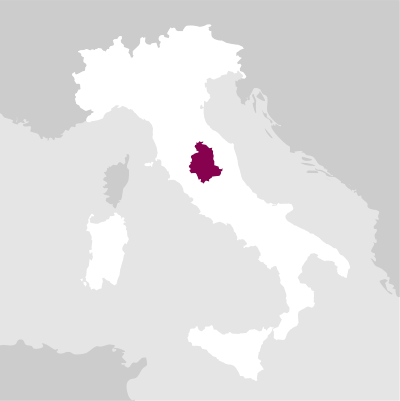Castello della Sala is located in Umbria, a short distance from the Tuscan border, about 18 kilometers from the historic city of Orvieto. Castello della Sala, a magnificent medieval manor with 600 hectares (1482 acres) of land 229 (566 acres) of which are planted with vineyards, is located halfway between the Paglia river and the summit of Monte Nibbio.
The estate’s 229 hectares (566 acres) of vineyards are located at an altitude of 220 - 470 meters above sea level (722-1542 feet) and are planted with traditional varieties such as Procanico and Grechetto but also with Chardonnay, Sauvignon Blanc, Sèmillon, Pinot Blanc, Viognier and a small quantity of Traminer and Riesling.
The region is exceptional for producing white varieties with one exception, Pinot Noir, that has found ideal conditions in this terroir to best express its full potential. The vines grow in clay and calcareous based soils, rich in fossil shells, and they are well exposed to the rising of the sun with an excellent difference of temperature between day and night.
Castello della Sala (Antinori)

创办年份
1940
酿酒师
Massimiliano Pasquini
生产的瓶子
866.586
公顷
229
种植类型
Non-organic farming
位置
Loc. Sala - Ficulle (TR)

Umbria
未找到产品
减少使用的筛选条件数量或删除所有筛选条件
减少使用的筛选条件数量或删除所有筛选条件
-
 97 RPRobert Parker
97 RPRobert Parker
The prestigious international wine guide from the renowned Robert Parker, the world's most experienced and trusted wine taster.97 JSJames Suckling
James Suckling is an influential American wine critic and journalist who worked at Wine Spectator for 30 years. He left the magazine in 2010 to start his own website and guidebook (JamesSuckling.com). He specialises in Italian and Bordeaux wines.95 VOVinous
Vinous is the online guide from Antonio Galloni, one of the world's leading wine connoisseurs.13.0%常规价格 HKD654.00常规价格 HKD654.00 促销价 单价 单价 -
 12.5%常规价格 HKD207.00
12.5%常规价格 HKD207.00常规价格 HKD207.00 促销价 单价 单价 -
 3 GRGambero Rosso
3 GRGambero Rosso
This guide is highly respected and offers the most comprehensive review of Italian wines. It has a long tradition and is based on blind tastings carried out by over 100 experts.12.0%常规价格 HKD177.00常规价格 HKD177.00 促销价 单价 单价 -
 3 GRGambero Rosso
3 GRGambero Rosso
This guide is highly respected and offers the most comprehensive review of Italian wines. It has a long tradition and is based on blind tastings carried out by over 100 experts.12.5%常规价格 HKD175.00常规价格 HKD175.00 促销价 单价 单价 -
 12.0%常规价格 HKD267.00
12.0%常规价格 HKD267.00常规价格 HKD267.00 促销价 单价 单价 -
 4 VTVitae AIS
4 VTVitae AIS
Italian Sommelier Association (AIS) guide5 BBBibenda
Italian Sommelier Foundation (FIS) guide This has been one of the most prestigious wine guides in Italy for over 10 years.93 VOVinous
Vinous is the online guide from Antonio Galloni, one of the world's leading wine connoisseurs.12.5%常规价格 HKD374.00常规价格 HKD374.00 促销价 单价 单价 -
 常规价格 HKD38.00
常规价格 HKD38.00常规价格 HKD38.00 促销价 单价 单价 -
 12.0%常规价格 HKD271.00
12.0%常规价格 HKD271.00常规价格 HKD271.00 促销价 单价 单价 -
 97 RPRobert Parker
97 RPRobert Parker
The prestigious international wine guide from the renowned Robert Parker, the world's most experienced and trusted wine taster.97 JSJames Suckling
James Suckling is an influential American wine critic and journalist who worked at Wine Spectator for 30 years. He left the magazine in 2010 to start his own website and guidebook (JamesSuckling.com). He specialises in Italian and Bordeaux wines.95 VOVinous
Vinous is the online guide from Antonio Galloni, one of the world's leading wine connoisseurs.13.0%常规价格 HKD414.00常规价格 HKD414.00 促销价 单价 单价售罄 -
 13.5%常规价格 HKD509.00
13.5%常规价格 HKD509.00常规价格 HKD509.00 促销价 单价 单价售罄 -
 5 BBBibenda
5 BBBibenda
Italian Sommelier Foundation (FIS) guide This has been one of the most prestigious wine guides in Italy for over 10 years.12.5%常规价格 HKD375.00常规价格 HKD375.00 促销价 单价 单价 -
 98 JSJames Suckling
98 JSJames Suckling
James Suckling is an influential American wine critic and journalist who worked at Wine Spectator for 30 years. He left the magazine in 2010 to start his own website and guidebook (JamesSuckling.com). He specialises in Italian and Bordeaux wines.13.0%常规价格 HKD1,694.00常规价格 HKD1,694.00 促销价 单价 单价售罄














